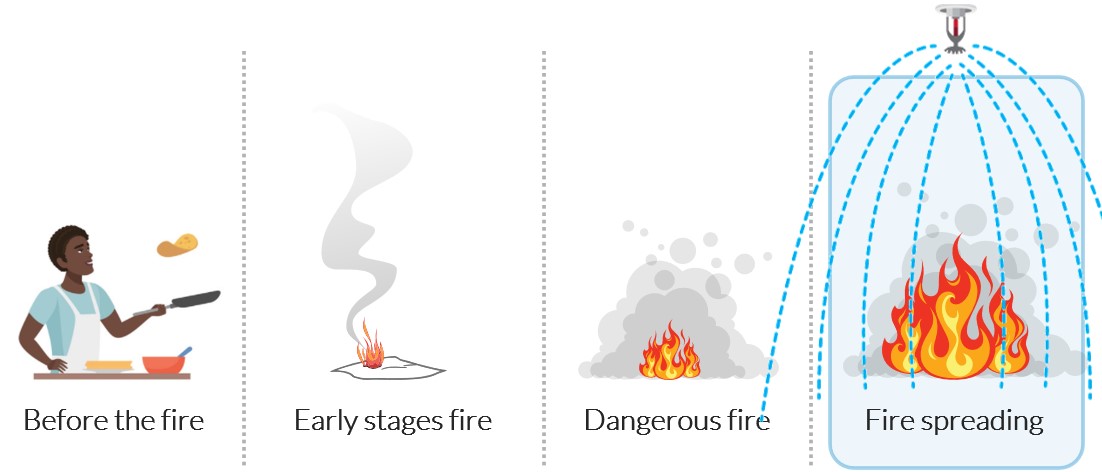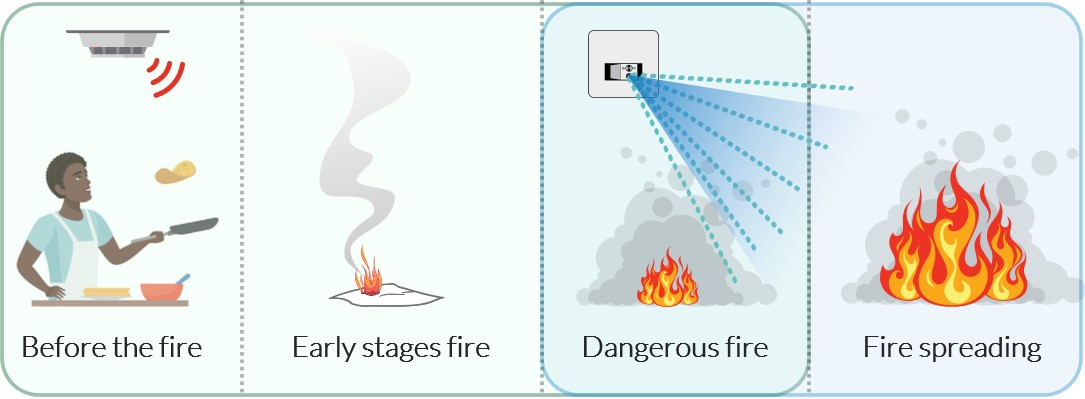Traditional fire sprinklers are designed to operate when affected by the heat from a fire. Most sprinkler heads feature a glass bulb filled with a glycerin-based liquid, which expands when it comes into contact with heated air, shattering the glass and activating the sprinkler head.
Sprinklers are most effective at tackling fast-growing fires, like an old sofa fire, as the activation temperature threshold is breached quickly, minimising the time for toxic gas production. When activated, sprinklers can prevent flashover – one of the most-feared phenomena among firefighters – it is the near-simultaneous ignition of most of the directly exposed combustible material in an enclosed area.
Preventing or delaying flashover is pivotal, but the time it takes before a fire creates enough heat to operate a sprinkler (if at all, if the fire is outside its operating parameters) is also critical when the protection of vulnerable occupants is at stake.
Early activation and early warning with Automist
Automist Smartscan activates electronically, overcoming the constraints of existing sprinkler systems by operating earlier, before the temperature required to burst the glass bulb of a sprinkler and tackling fires before they generate that amount of heat, helping to reduce smoke and maintain survivability. Automist is proven to operate 2.0 to 13.7 times quicker than a concealed sprinkler for many scenarios.

A reliable integrated early warning smoke and heat combination alarm is part of every installation to raise the alarm long before the fire emerges. This sensor can be coupled with a communications device for remote monitoring to inform a responsible person or call for help.
In 2019/20, thankfully, only 7% of the 775 fires in purpose-built high-rise flats spread beyond the room of origin. In part, this is due to effective compartmentation between spaces and early reporting and response by the authorities. Nonetheless, the most common cause of death for fire-related fatalities was ‘overcome by gas or smoke’, reported for 30% (73) of fire-related fatalities.
All combustible materials produce toxic smoke when they burn, but how much depends on the material, the amount of oxygen available and how long it burns. The risk can vary significantly depending on the health and age of the occupant.
A single exposure to toxic gases from a house fire can have severe long-term effects that may occur immediately and clear up after a few days or result in a permanent injury. Although it can be complicated trying to distinguish between causal effects and coincidental illnesses, there is a wide range of possible long-term effects resulting from smoke inhalation.
A reduced supply of oxygen (hypoxic episode) can result in unconsciousness followed by recovery after oxygen treatment with permanent brain damage. Mineral particles or fibres are released in a fire that can result in permanent lung damage and even cancer some years following a single incident. Many are calling for more research into these long-term effects, and we must ensure these factors do not go ignored or become invisible.
An electronically controlled trigger means Automist can activate significantly earlier before significant heat build-up. This reduces the chance of burns for someone very close to a fire and minimises the production of life-threatening toxic gases, which are still the most significant threat in domestic fires.

